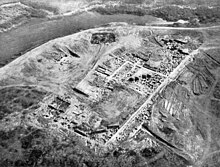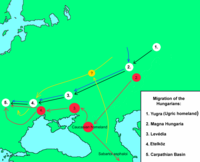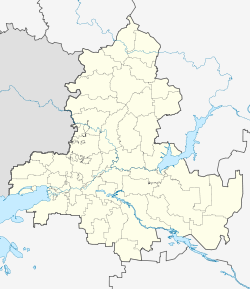Sarkel
- Tür: Kale
- Tema: Kaybolan Kültür Varlıkları
- Kültür: Bizans, Hazar
- Yüzyıl: 9. yy
- Bölge: Rusya
- Durum: Kayıp
Sharkil | |
 Aerial photo of the excavations conducted at Sarkel in the 1930s. | |
| Location | Russia |
|---|---|
| Region | Rostov Oblast |
| Coordinates | 47°42′18″N 42°16′23″E / 47.70500°N 42.27306°E |
| Type | Fortification |
| History | |
| Builder | Khazars, Byzantine Empire |
| Founded | 830s |
| Cultures | Khazar |
| Site notes | |
| Excavation dates | 1930s |
| Archaeologists | Mikhail Artamonov |
| Condition | Submerged by Tsimlyansk Reservoir |


Sarkel (or Šarkel, literally "white house" in the Khazar language[1][2]) was a large limestone-and-brick fortress in what is now Rostov Oblast of Russia, on the left bank of the lower Don River.
It was built by the Khazars with Byzantine assistance in the 830s or 840s.[3] It was named Sarkel, or 'white-house', because of the white limestone bricks used in its construction.
- ^ D.M. Dunlop, The History of the Jewish Khazars, Princeton University Press (1954).
- ^ The first part Sar is cognate with Chuvash šur 'white', while kel/kil reflects a now lost West Middle Iranian cognate of Sanskrit grḥ a ‘house’, Russian gorod ‘town’, Gothic garths ‘house’. Marcel Erdal, Khazar Language, in Peter B. Golden et al. (eds.). The World of the Khazars. New Perspectives. BRILL pp. 75-108,pp.85-86; Károly Cseglédy, "Šarkel: An Ancient Turkish Word for 'House'" in D.Sinor, ed., Aspects of Altaic Culture (Uralic and Altaic studies no. 23) (Bloomington and the Hague, 1963), pp. 23-31.
- ^ D.M. Dunlop and Arthur Koestler both date the construction to around 833 (Dunlop 186; Koestler, The Thirteenth Tribe, Random House (1976), p. 85); Peter B. Golden states Sarkel was built 'with Byzantine assistance in 840-41' ("The Conversion of the Khazars to Judaism", in: Peter B. Golden et al. The World of the Khazars. New Perspectives, Brill (2007), p. 150); and Marcel Erdal provides the date 838 ("The Khazar Language", in: Peter B. Golden et al. (2007), p. 85).

